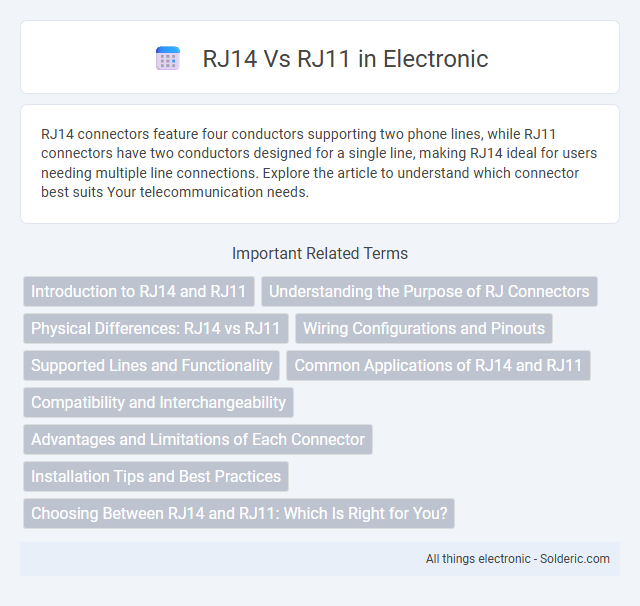RJ14 connectors feature four conductors supporting two phone lines, while RJ11 connectors have two conductors designed for a single line, making RJ14 ideal for users needing multiple line connections. Explore the article to understand which connector best suits Your telecommunication needs.
Comparison Table
| Feature | RJ14 | RJ11 |
|---|---|---|
| Connector Type | 6P4C (6 positions, 4 contacts) | 6P2C or 6P4C (commonly 6P2C) |
| Wiring | Four wires | Two wires |
| Usage | Two telephone lines | Single telephone line |
| Compatibility | Works with RJ11 jacks | Not designed for multiple lines |
| Common Application | Multi-line telephone systems | Home telephone devices |
Introduction to RJ14 and RJ11
RJ14 and RJ11 are common modular connectors used in telephone wiring, with RJ11 typically supporting a single phone line through its 6-position, 2-conductor design, and RJ14 accommodating two phone lines via a 6-position, 4-conductor configuration. Your choice between RJ14 and RJ11 depends on the number of telephone lines needed; RJ11 is ideal for standard home phones, while RJ14 suits settings requiring dual-line setups. Both connectors fit into standard telephone jacks but differ in wiring complexity and functionality based on line requirements.
Understanding the Purpose of RJ Connectors
RJ14 and RJ11 connectors serve distinct purposes in telecommunication wiring, with RJ11 typically supporting single-line telephone connections and RJ14 designed to handle dual-line setups. Understanding the purpose of RJ connectors helps you choose the right interface for your phone system needs, ensuring compatibility and optimal signal transmission. RJ14 connectors feature four conductors, whereas RJ11 usually has two, facilitating different levels of connectivity for residential and business phone lines.
Physical Differences: RJ14 vs RJ11
RJ14 connectors feature a 6-position, 4-conductor (6P4C) configuration, designed to support two telephone lines, whereas RJ11 connectors have a 6-position, 2-conductor (6P2C) layout primarily for a single line. The additional conductors in RJ14 enable simultaneous dual-line communication, making it suitable for multi-line phone systems. Physically, both connectors appear similar in size, but the wiring and pin assignments distinguish their respective functionalities.
Wiring Configurations and Pinouts
RJ14 and RJ11 connectors differ primarily in their wiring configurations and pinouts, with RJ14 using a 6P4C (six positions, four contacts) setup while RJ11 typically employs 6P2C or 6P4C configurations. RJ14's four active wires support two separate telephone lines, making it ideal for multi-line systems, whereas RJ11 mainly carries a single line with two or four wires. Understanding the specific pinout differences can help you ensure compatibility and optimal performance in your telecommunication installations.
Supported Lines and Functionality
RJ14 supports two telephone lines simultaneously, allowing separate incoming and outgoing calls on each line, while RJ11 is designed to support a single telephone line. RJ14 connectors have six positions and four conductors (6P4C), enabling multi-line functionality, whereas RJ11 connectors usually have six positions but only two or four conductors (6P2C or 6P4C), limiting them to one line. This difference in supported lines and conductors directly impacts their usage in multi-line telephone systems versus standard single-line connections.
Common Applications of RJ14 and RJ11
RJ11 connectors are primarily used for single-line telephone connections in residential and small office settings, supporting standard voice communication and basic fax services. RJ14 connectors accommodate two telephone lines, making them suitable for multi-line telephone systems and small business environments that require simultaneous voice channels. Both connectors are compatible with traditional PSTN networks, but RJ14's dual-line capability distinguishes it in applications needing expanded telephony options.
Compatibility and Interchangeability
RJ14 and RJ11 connectors differ primarily in their wiring and number of conductors, with RJ14 supporting four wires for two phone lines and RJ11 typically supporting two wires for a single line. RJ14 is backward compatible with RJ11 jacks, allowing RJ11 plugs to fit into RJ14 sockets, but RJ11 devices cannot utilize the additional line provided by RJ14 cabling. Interchangeability is possible physically, but functionality depends on the telephone service requirements and wiring configuration.
Advantages and Limitations of Each Connector
RJ14 offers the advantage of supporting two telephone lines on a single jack, which increases functionality in multi-line telephony systems compared to RJ11, which only supports one line. RJ11 is simpler, more widely used, and cost-effective for basic home phone setups, but it cannot handle multiple lines, limiting its versatility in business environments. Your choice depends on whether you need single or dual line capability, balancing the simplicity of RJ11 against the enhanced connectivity of RJ14.
Installation Tips and Best Practices
When installing RJ14 and RJ11 connectors, ensure proper identification of wiring standards; RJ14 typically supports two phone lines with four wires, while RJ11 handles one line with two wires. Use a punch-down tool for secure termination, maintaining consistent wire color order according to T568A or T568B standards to prevent cross-talk and signal interference. Test connections with a phone line tester to verify continuity and proper operation before finalizing installation.
Choosing Between RJ14 and RJ11: Which Is Right for You?
Choosing between RJ14 and RJ11 depends primarily on the number of phone lines you need to support; RJ11 is designed for a single phone line with 2 or 4 wires, while RJ14 supports two phone lines using 4 or 6 wires. RJ14 is ideal for businesses or homes requiring multiple lines, offering compatibility with devices like multiline phones or PBX systems. For basic telephony needs with one line, RJ11 remains the more cost-effective and simpler solution.
RJ14 vs RJ11 Infographic

 solderic.com
solderic.com